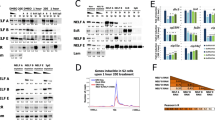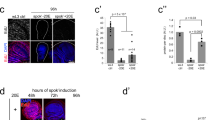Abstract
ECDYSONE in Drosophila has been a paradigm for steroid hormones since its ability to induce gene activity directly was demonstrated by its effects on moulting and polytene chromosome puffing1–3. The ecdysone receptor (EcR) was recently confirmed as a member of the nuclear receptor superfamily by cloning and characterization in a Drosophila cell line4. Here we show that EcR needs to heterodimerize with either the retinoid X receptor (RXR)5 or its Drosophila homologue, ultraspiracle (USP)6, for DNA binding and transactivation. These results place the ecdysone receptor in the heterodimerizing class of the nuclear receptor superfamily and demonstrate that the role of RXR/USP as a central and promiscuous partner in mediating the activity of these receptors7–12 is highly conserved. Whereas EcR-USP DNA-binding activity is unaffected by hormone, EcR-RXR DNA-binding activity is stimulated by either ecdysteroid or 9-cis-retinoic acid, demonstrating that hormone can play a role in heterodimer stabilization.
This is a preview of subscription content, access via your institution
Access options
Subscribe to this journal
Receive 51 print issues and online access
$199.00 per year
only $3.90 per issue
Buy this article
- Purchase on Springer Link
- Instant access to full article PDF
Prices may be subject to local taxes which are calculated during checkout
Similar content being viewed by others
References
Clever, U. & Karlson, K. Expl Cell Res. 20, 623–626 (1960).
Clever, U. Science 146, 794–795 (1964).
Ashburner, M. Cell 61, 1–3 (1990).
Koelle, M. R. et al. Cell 67, 59–77 (1991).
Mangelsdorf, D. J., Ong, E. S., Dyck, J. A. & Evans, R. M. Nature 345, 224–229 (1990).
Oro, A. E., McKeown, M. & Evans, R. M. Nature 347, 298–301 (1990).
Yu, V. C. Cell et al. 67, 1251–1266 (1991).
Leid, M. et al. Cell 68, 377–395 (1992).
Zhang, X. k., Hoffmann, B., Tran, P. B.-V., Graupner, G. & Pfahl, M. Nature 355, 441–445 (1992).
Kliewer, S. A., Umensono, K., Mangelsdorf, D. J. & Evans, R. M. Nature 355, 446–449 (1992).
Bugge, T. H., Pohl, J., Lonnoy, O. & Stunnenberg, H. G. EMBO J. 11, 1409–1418 (1992).
Marks, M. S. et al. EMBO J 11, 1419–1435 (1992).
Riddihough, G. & Pelham, H. R. B. EMBO J. 6, 3729–3734 (1987).
Martinez, E., Givel, F. & Wahli, W. EMBO J. 10, 263–268 (1991).
Petkovich, M., Brand, N. J., Krust, A. & Chambon, P. Nature 330, 444–450 (1987).
Giguere, V., Ong, E. S., Segui, P. & Evans, R. M. Nature 330, 624–629 (1987).
Sap, J. et al. Nature 340, 242–244 (1989).
Wang, H. et al. Nature 340, 163–166 (1989).
Zhang, X.-k. et al. Nature 358, 587–593 (1992).
Andersson, M. L. et al. Nucleic Acids Res. 20, 4803–4810 (1992).
Perrimon, N., Engstrom, L. & Mahowald, A. P. Genetics 111, 23–41 (1985).
Oro, A. E., McKeown, M. & Evans, R. M. Development 115, 449–462 (1992).
Schöler, H. R., Hatzopoulos, A. K., Balling, R., Suzuki, N. & Gruss, P. EMBO J. 8, 2543–2550 (1989).
MacGregor, G. R. & Caskey, T. C. Nucleic Acids Res. 17, 2365 (1989).
Franke, A. et al. EMBO J. 11, 2941–2950 (1992).
Amin, J., Mestril, R. & Voellmy, R. Molec. cell. Biol. 11, 5937–5944 (1991).
Chen, C . & Okayama, H. Molec. cell. Biol. 7, 2745–2752 (1987).
Christopherson, K. S., Mark, M. R., Bajaj, V. & Godowski, P. J. Proc. natn. Acad. Sci. U.S.A. 89, 6314–6318 (1992).
Green, S., Issemann, I. & Sheer, E. Nucleic Acids Res. 16, 369 (1988).
Author information
Authors and Affiliations
Rights and permissions
About this article
Cite this article
Thomas, H., Stunnenberg, H. & Stewart, A. Heterodimerization of the Drosophila ecdysone receptor with retinoid X receptor and ultraspiracle. Nature 362, 471–475 (1993). https://doi.org/10.1038/362471a0
Received:
Accepted:
Issue Date:
DOI: https://doi.org/10.1038/362471a0
This article is cited by
-
A novel approach to co-expression network analysis identifies modules and genes relevant for moulting and development in the Atlantic salmon louse (Lepeophtheirus salmonis)
BMC Genomics (2021)
-
The development of body and organ shape
BMC Zoology (2020)
-
Maturation of telotrophic ovary accompanied with ecdysteroidogenic activity and contrastive decrease in ecdysteroids in the whole body of red flour beetle, Tribolium castaneum (Coleoptera: Tenebrionidae)
Applied Entomology and Zoology (2020)
-
MicroRNA let-7 regulates the expression of ecdysteroid receptor (ECR) in Hyalomma asiaticum (Acari: Ixodidae) ticks
Parasites & Vectors (2019)
-
Autophagy-dependent cell death
Cell Death & Differentiation (2019)
Comments
By submitting a comment you agree to abide by our Terms and Community Guidelines. If you find something abusive or that does not comply with our terms or guidelines please flag it as inappropriate.



